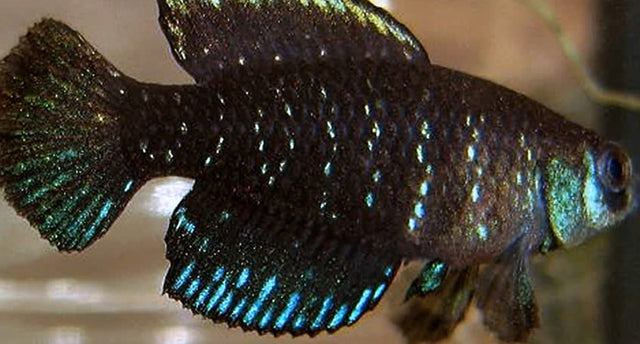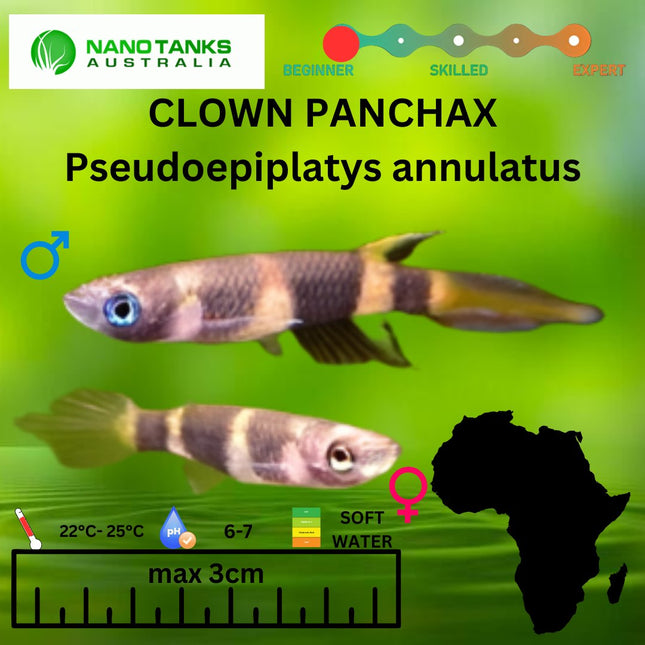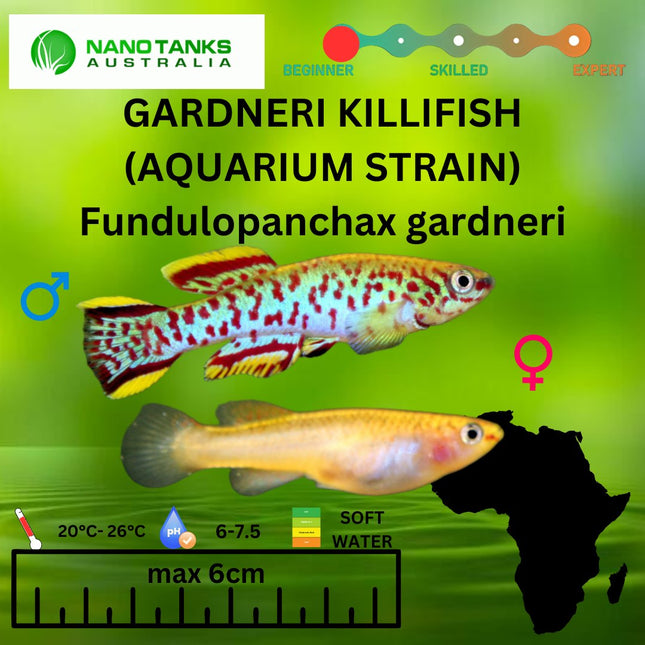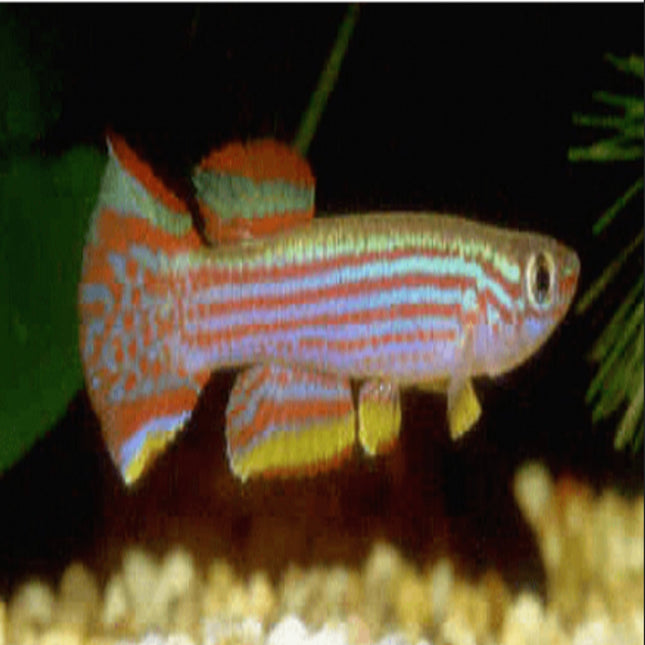Check out our range of stock.
Didn't find what you like?
Send us a message
Found something out of stock?
Send us a message

This Category is lumped together of all the species we normally get in Australia. We usually can have access to a variety of Killifish.
If we don't have any in stock we encourage you to send us a message.

Aphyosemion Australe Cape Lopez, also known as the Kap Lopez Killifish, is a popular species of freshwater fish that is often kept in aquariums. This fish is native to West Africa, specifically the coastal regions of Gabon, where it inhabits small streams, swamps, and marshes. The Kap Lopez Killifish is a small, colorful fish that can grow up to about 2 inches in length. The males are generally more brightly colored than the females, with vibrant hues of blue, green, and red. The females tend to be a bit duller in color, with shades of brown and yellow. These fish are known for their peaceful temperament and are generally not aggressive towards other fish. They are also relatively easy to care for, as they are hardy and adaptable to a range of water conditions. However, it is important to keep them in a well-maintained aquarium with clean, well-filtered water and plenty of hiding places. In terms of breeding, the Kap Lopez Killifish is a type of annual killifish, which means that they have a short lifespan of only about one year. However, they are prolific breeders and can produce many eggs during their short lifespan. Breeding them requires careful attention to their water conditions, as well as a breeding tank with plenty of plants and hiding places for the fry.
$50.00

(Male Pictured) Aphyosemion Australe Chocolate is a killifish that prefers softer water, but a pH of 6.5 - 7.0 is going to be ideal. These killifish are able to be kept in smaller community setups, some chasing may be present within the species, but given enough space to get away and hide there should not be any other issues.
$80.00

Aphyosemion australe Gold is a type of freshwater fish native to West Africa. It is a member of the Aplocheilidae family and is a member of the Aphyosemion genus. It is an attractive fish with a yellowish-gold body and black stripes along its back and sides. The male has a blue-green head and dorsal fin, while the female has a yellow-orange head and dorsal fin. It prefers slow-moving, heavily-vegetated water bodies. It is an omnivore and feeds on both aquatic and terrestrial insects, crustaceans, and algae. Its maximum size is about 4 inches in length. It is a peaceful fish and can be kept in a community aquarium with other peaceful species.
$50.00

Also known as the two striped killfish, this species is widely-distributed in lowland, coastal regions of Togo, Benin and Nigeria as far as the Cross River delta, and occurs at some inland localities along the lower Niger River. Populations in Cameroon, Equatorial Guinea and Gabon are now considered to represent other species. These beautiful reddish-orange coloured fish are suitable for community tanks with smaller, more peaceful fish like tetras and catfish. A must for any aquarist who love to see streamlined, elongated fish swimming in their community tanks! Sources Aphyosemion bitaeniatum. Seriously Fish. Retrieved 7th September, 2019.
$80.00

Aphyosemion filamentosum is a pair of fish native to the savannas of Central Africa. They are small and colorful, growing to a maximum length of only 2 inches. Their bodies are a deep gold color with small black stripes and they have a single black and white stripe that runs down their back. The fins are yellow and black, and they have a bright yellow tail. Their scales are transparent, allowing a beautiful pattern to be seen. They are peaceful and shy, and prefer to hide in the thick vegetation of their natural habitat. They are omnivorous, feeding on zooplankton, insect larvae, small crustaceans, and plant matter. They are an excellent choice for a peaceful community tank, and will thrive with proper care.
$80.00

Gardneri killifish do well in community aquariums although it is important to keep the fish tank covered at all times, as these fish are prone to jumping. There should be very minimal lighting, and accordingly so, only live plants that can tolerate low light conditions such as crypts (Cryptocoryne sp.) and java moss (Vesicularia dubyana) should be considered. Ideally, the aquarium should be long and have reduced water movement to mimic their natural habitat. Dimorphism: Typically the males will exhibit vivid colors and will be larger than the females. Fecundity: This type of killifish prefers planted aquariums and can lay their eggs on java moss or spawning mops. It is recommended to remove the adults after spawning has been observed or thought to have occurred. Fry will gladly accept live baby brine shrimp. Water Chemistry: 73-79° F, KH 5-8, pH 6.0-7.5.Gold gardneri killifish prefer water that is on the acidic side, so consider supplementing their water with peat moss or driftwood, which can naturally decrease pH. Aquarium Diet: Adult killifish prefer live and frozen foods such as brine shrimp and blood worms, although some will accept dry foods such as flakes and pellets as well. Some killifish can be picky eaters. If this is the case with yours, feed live food and gradually introduce it to dry food as well. Compatibility: Male killifish can be aggressive towards one another. If multiple pairs are being housed, make sure the aquarium is sufficient in size and areas for the killifish to retreat to if they feel threatened. Some other tankmates can include tetra species such as pristella tetras (Pristella maxillaris) or rosy tetras (Hyphessobrycon rosaceus), Corydoras species, and danio species such as the pearl danio (Danio albolineatus).
$40.00

Aphyosemion poliaki is a species of killifish native to Central African Republic, Cameroon, and Equatorial Guinea. This species is part of the Aphyosemion genus, which consists of many different killifish species that are found throughout Africa. Aphyosemion poliaki are a small fish, growing to a maximum adult size of around 2 inches. They have a short, elongated body, with a broad head and bright colors. Males are typically a bright yellow or orange, while females are usually a light grey-brown. Aphyosemion poliaki are an attractive species, and are often kept in aquariums. They are relatively easy to care for, and require a soft substrate such as sand or gravel, as well as plenty of hiding places. They are also an egg-laying species, and will lay their eggs in fine-grained materials such as sand or fine gravel.
$60.00

Austrolebias nigripinnis, also known as the black-finned annual killifish, is a stunning freshwater fish species that originates from South America. With its vibrant coloration and unique body shape, this fish is a popular choice among aquarium enthusiasts. The males feature a bright red-orange coloration on their body, while the females are more subdued with a silvery coloration. Austrolebias nigripinnis is a relatively small fish, growing up to 3 inches in length. They prefer living in heavily planted aquariums with plenty of hiding spots, as they can be a bit shy. They are known to be relatively hardy and can adapt well to different water parameters, making them a great choice for beginner aquarists. Austrolebias nigripinnis is a carnivorous fish species that feeds on small invertebrates and insects in the wild. In an aquarium, they can be fed a variety of foods including flakes, pellets, and frozen or live foods. It's important to avoid overfeeding this species as they are prone to obesity. Overall, Austrolebias nigripinnis is a beautiful and fascinating fish species that can make a great addition to any freshwater aquarium. With proper care and attention, they can thrive and bring joy to their owners for years to come.
$50.00

The Blue Panchax is known from heavily vegetated canals, ditches, ponds, reservoirs, and lowland wetlands. It is not unknown for them to move into slightly brackish waters in mangrove creeks, and they thrive on eating the mosquito larvae which land on the water’s surface. A pair of these top-dwelling fish require an aquarium 3ft long, and if a larger group (including more males) are to be kept together, a more spacious tank must be provided. The aquarium itself should be aquascaped with plenty of plants, including floating varieties wherever possible. This will give the fish a natural network of hiding places and territories. Tangles of driftwood can also be added to give additional shelter. Blue Panchax are accomplished jumpers, so it is essential that the tank has tight fitting coverslides. These fish are predatory and have surprisingly wide mouths (view them head-on). Therefore they should never be combined with small community fish e.g. Neon Tetras, as these will soon become a snack. Blue Panchax are best maintained with medium sized fish of a peaceful disposition, and which do not occupy the same extreme top level of the aquarium. Interestingly, in their native homelands, this species is referred to as the ‘White Spot’ on account of the bright silver-white mark on top of the head when viewed from abov Feeding These fish require a good variety of meaty frozen foods, as in the wild they are known to take insects and insect larvae from the water’s surface. Bloodworm and white mosquito larvae are preferred, but they will also enjoy vitamin-enriched brineshrimp and daphnia. Breeding A chosen conditioned pair should be acclimatised to a softwater breeding aquarium furnished with large clumps of fine leaved plants and floating plants. Some aquarists prefer to condition the male and female in separate tanks prior to bringing them together in the breeding aquarium. The eggs, which are of quite a large size, will be deposited amongst the plants near the water’s surface. From here it is easy to transfer them to another growing-on tank so that the parent fish do not predate on them (alternatively, carefully remove the parent fish from this aquarium once spawning has ceased). The eggs usually number between 100 and 150, but up to 250 have been reported from one spawning. These eggs can be expected to hatch within 11-14 days (temperature dependant) and the young offered finely powdered ‘first foods’ and newly hatched brineshrimp. Common Name – Blue Killie Panchax Origin – Western Africa Diet – carnivorous PH Range – 4 – 7 Temperature – Tropical 26°c – 28°c Breed Type – Egg Layer Maximum Size – approximately 9cm Sex – Un-sexed
$10.00

The Golden Panchax is an excellent surface dwelling fish for peaceful communities. The fish has a unique appearance thanks to its reflective scales, shape, and unusual mouth which appears to 'grin'. These are natural surface dwellers and will rarely swim down, so surface foods are important, as well as cover such as floating plants, tall plants, or decor at the surface. An interesting feature of this fish is a large reflective scale on the top of the head, which is used in the wild to attract insects for food. Golden panchax's are robust and adaptable and will do well in a suitable aquarium environment. Golden Panchax Facts Family Aplocheilidae (Killifishes) | Synonyms Haplochilus playfairii, Panchax playfairii, Pachypanchax playfairii, Panchax lineatus, Haplochilus lineatus, Panchax rubrostigma, Aplocheilus rubrostigma | Other names Golden wonder, Striped panchax, Sparkling panchax | Origin Asia; India, Sri Lanka | Breeding Egg scatterer | Natural Water Conditions pH 6-8, soft to hard | Natural Habitat Fresh and brackish ponds and small waterways | Sexing Males have a more intense colour, mature males may show some orange on fins Reference: https://www.thinkfish.co.uk/fish/golden-panchax.html Image from: http://animal-world.com/encyclo/fresh/Killifish/StripedPanchaxKillifish.php
$15.00

Hypsolebias coamazonicus, also known as the Maracaibo Red Fin Killifish, is a small freshwater fish species that is native to South America. This species is known for its vibrant coloration, with the males featuring bright red fins that contrast sharply against their blue-green bodies. In the aquarium hobby, Hypsolebias coamazonicus is popular among killifish enthusiasts due to their striking appearance and ease of care. They prefer soft, slightly acidic water with a pH between 6.0 and 7.0 and a temperature range of 72-82°F. They are relatively peaceful and can be kept in a community aquarium with other peaceful species of a similar size. Hypsolebias coamazonicus is an annual killifish, meaning that they have a short lifespan of about one year. However, they are prolific breeders and will lay their eggs on the substrate, which can be collected and incubated to hatch fry. Overall, Hypsolebias coamazonicus is a stunning fish species that is perfect for aquarists looking to add a vibrant and easy-to-care-for fish to their community tank.
$50.00

Described By: (Boulenger), 1915 😊 Description Temperament Peaceful Predator Colour Form Varied Bright Colours. Males - Coloured Tails ♂️ Females - Plain Tails ♀️ Lifespan Roughly 5 years Diet 🥩 Carnivores - feeds on pellets, live foods and frozen foods. Minimum Tank Size 20 Litres Tank Setup Plants - Such as Duckweed, Anubias or Java Fern with many rocks and woods. Such as Dragon Stone, Dragon Wood, Quan Woods. Compatibility Peaceful - However due to the size please be aware that it can be eaten by bigger fish. To keep your Clown Killifish happy, their habitat should be well lit, water parameters excellent, and a gentle current from the filter set. If you give your clown Killies these conditions, they can live for 5 years! Rocket Killie Clown Killies are also known as rocket killies and banded panchax. Coming from western Africa, they are found in southern Guinea, Liberia, and Sierra Leone. The Clown Killifish is a peaceful micro-predator that feeds primarily on tiny flying insects and invertebrates. 😊 Can we expect some clowning around? Clown Killifish are shy (they are rather small) but they will become more playful when in a group, so expect some interesting schooling behaviour. They even enjoy jumping out of the water for some fun! Make sure to keep their tank lid tightly fitted so that these fish can have as much space as possible to live and play around without the risk of an excursion on the floor. 😊 A unique look Clown Killifish are also called Rocket Killies because they resemble tiny rockets. In addition, they have torpedo-shaped bodies that help them swim up for food, and they even appear as a fishy clown with round heads and spade-like tails. 😊 Keeping Clown Killifish in the Aquarium You can choose to house Clown Killies in larger community tanks that are already occupied by other species. The downside is the fish won't reproduce as often if they're placed with another type of inhabitant, so you should know what kind of goal you have for keeping these types of fishes before giving them a home. 😊 Are these fish easy to breed? If you have a male and female in your tank, don't worry about mating. Just maintain healthy water parameters to keep them alive, and they will breed when it's the right time every month! Clown Killies are prolific parents who can produce up to 25 fry per cycle - twice each month until their population numbers get out of hand! 😊 Feeding your Clown Killies Clown Killies are carnivores that need a lot of meaty protein, but they can only eat tiny portions. They lay in wait for the insects to land on the water's surface and then eat their prey - or what could be considered for them a tasty meat morsel! Ideally, in captivity, we can try mimicking what can be in the natural environment: baby brine shrimp 1-2 times a day should do it! There is advice on other foods on the internet but realistically, sticking with brine shrimp for a treat is good enough and achievable without spending a fortune. PLEASE CONTACT US FIRST BEFORE YOU ORDER ANY FEMALES AS WE WILL HAVE TO CHECK OUR STOCK!
$15.00

Described By: (Boulenger), 1911 😊 Description Temperament Peaceful Predator Colour Form Varied Bright Colours. Males - Coloured Bodies and Tails ♂️ Females - Brownish in colour ♀️ Lifespan Roughly 5 years Diet 🥩 Carnivores - feeds on pellets, live foods and frozen foods. Minimum Tank Size 20 Litres Tank Setup Plants - Such as Duckweed, Anubias or Java Fern with many rocks and woods. Such as Dragon Stone, Dragon Wood, Quan Woods. Compatibility Peaceful - However due to the size please be aware that it can be eaten by bigger fish. ⚠️ This is an aquarium strain - this means that the strain of fish has been farm raised by many generations. The location for which this Killifish is caught has been lost. The Fundulopanchax gardneri Killifish is native to the Cross River system in southeastern Nigeria and western Cameroon plus the Benue River drainage in central Nigeria. The Gardneri Killifish, also known as Aphyosemion gardneri is an attractive fish that adds vibrancy to the community aquarium. This species of killy lives in Africa and was named after a Dutch word for channel or ditch because its native habitat is small of water. Fundulopanchax gardneri Killifish adds vibrant colour to the community tanks with their bright blue/green bodies spotted with red spots. The male lyretail anthias are a vivid blue/green with many red spots over their body. The tips of the dorsal, anal and caudal fin have golden fringes that run along with them. Meanwhile, females are less intensely coloured with small brown spots covering their bodies instead of complex patterns like males do. This species is known for having short extensions on its tail fins which result in an effect called "lyretails." There's such variety between color varieties it can be hard to keep track! 😊 Tank Requirements Gardneri Killifish are not picky and can adapt to a variety of water conditions. These fish prefer heavily planted tanks with softer, acidic water. To start with the setup you can cover the aquarium with plants and mops. Filtering that uses air is recommended since it won’t harm eggs or fry while they grow in size. Lighting isn't necessary but if used shouldn't be harmful to the growth of filamentous algae either. 😊 Reproduction The Gardneri Killifish is not an annual species. Their eggs do not need to be removed from the water after spawning - they can simply lay their eggs within a spawning mop or java moss, which are common types of vegetation in fish tanks. The parents don't even have to eat during this time period! It's very easy for their breed and once hatched, place the fry into a small tank with a newly hatched brine shrimp as a food source. Be sure that you cover your holding tank because these babies will jump out if given half the chance! 😊 Similar Species of Killifish: Many species of Fundulopanchax gardneri and other members in the genus are found throughout Africa - amieti, arnolde, fallace, filamentosum mireabileis puerzli robertsoni rubrolabbiales sjoedstedti walkeri 😊 Are Gardneri killifish aggressive? While the Killifish is a rather peaceful fish they can become aggressive to other female Killifish as well as other fish when breeding. If you want an all-male community tank, however, keep them with unassuming and colourless fishes like plecos or loaches.
$15.00

Distribution:Widely available from Equatorial Guinea (found in the lower Mitemele River drainage system), to northwestern Gabon (in the Mbei, Komo, Gabon, Abanga & lower Ogowe Rivers). An easy species to breed. Eggs are laid in top & bottom mops. Water incubation 13-15 days. Growth rate is quite rapid with sexual maturity being attained at about 4-5 months. Anthony Pinto in BKA Newsletter No.269 (January 1988) reported breeding them in water of 5 – 10 DH, pH 7, water temperature 24 – 26°C.Fry were fed newly hatched brine shrimp & microworm as a first food. Males were seen to start colouring up at 3 months.
$40.00